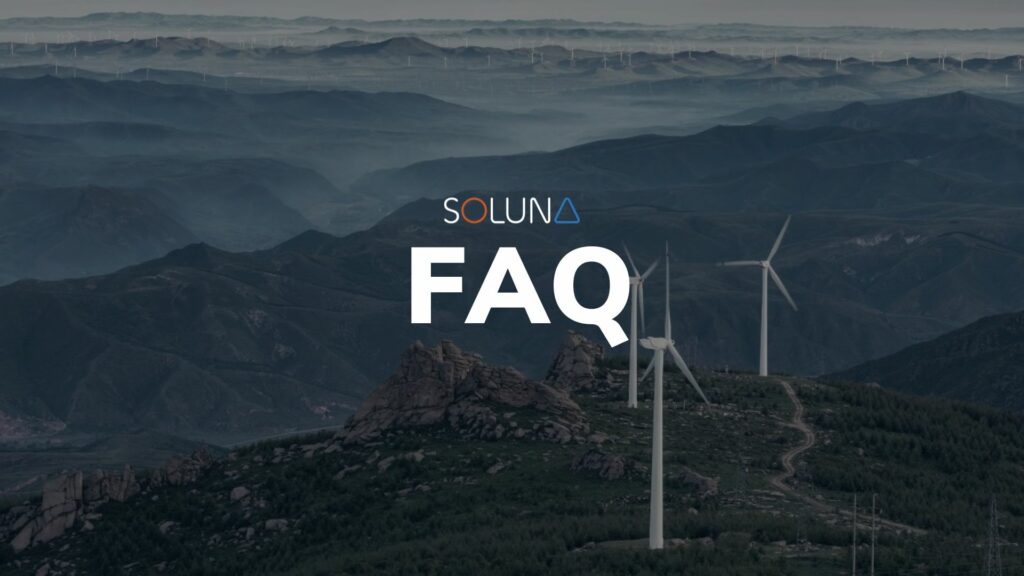Welcome to the start of Soluna’s new AMA (Ask Me Anything) series, where you — readers and our followers on Twitter and LinkedIn — can get your questions answered.
In this installment, John Belizaire, CEO of Soluna Computing, and Michael Toporek, CEO of Soluna Holdings (Nasdaq: SLNH), answer shareholders’ and potential investors’ most asked questions about our business model, development plans, Bitcoin HODLing, and more.
Let’s jump in!
Matias asked: When is Soluna going to diversify into other batchable computing services?
Michael Toporek [01:32]: Mattias, thanks for the great question. We’ve put out recently our plan for this year, and I expect that we will put together a one megawatt GPU facility this year, where we will compose our product offering, our go-to-market strategy, and our business plan.
I would expect that around mid-year, we’d announced exactly how we plan to do all that. Our goal will most likely be to have one customer, a reputable customer by the end of the year.
I would call it our organic plan, but we’re also looking for the right acquisitions where we can accelerate our efforts and at the same time add value. So, we’re pursuing both paths because we view this as a critical component to the company’s growth and the company’s future. John, anything you want to add to that?
John Belizaire [02:34]: Yeah, I think that’s right, Michael. We are looking at getting into diversification as early as this year. We think that Phase 2 of our business is so important.
Here we talk about Phase 1 and Phase 2. Phase 1 is crypto, Phase 2 is batchable computing. The batchable computing market is growing very rapidly, and we want to get into that space as quickly as possible.
Michael’s comment–starting with a smaller pilot facility where we can build out all of our capabilities in software and the operations, perfect that, and then scale it from there–that’s the same strategy we use with our crypto business if you folks have been following us for some time.
We started out our Washington facility– smaller, more focused. Now we’re scaling it at Sophie and Dorothy and beyond. We’re going to take the same strategy here with batchable computing. So thanks for that question, Mattias.
Jane asked: Can you discuss how the cost structure of Soluna batch computing service (that you are building) will compare to Amazon Web Services, let’s say in 5 years’ time?
Michael Toporek [03:58]: AWS is offering a fundamentally different service than we would be offering. That’s the starting point. We’re offering batchable computing that’s geared at a certain type of application that’s not always on, and we have what I call specialized equipment to handle. In addition, from a capital perspective, our facilities don’t require nearly the capital required of an AWS facility.
Remember, the AWS facility is always on. We don’t have to do that because we have a network of computing centers. We can move jobs around too. So our network’s always up and that’s how we can provide service to our customers.
That fundamental difference in capital cost creates a very different cost structure that we can pass on to our potential customers. That’s where the edge comes from, John, from an operational perspective. They’re also fundamentally different in that one’s more targeted and significantly less broad. Amazon is built to handle everybody.
This service we’re offering will handle niche applications really well at a good cost structure. But John, go ahead. Why don’t you put a little bit more meat on those bones?
John Belizaire [05:26]: No, that was great. I would add that the way to think about the overall computing space is that you have different types of computing loads.
You have real-time computing loads. These are the compute loads that you run your business on, your ERP system, your eCommerce platform, and so forth. That’s why big hyper-scale companies like Amazon build hyper redundant systems because those systems cannot go down.
At the same time, you have other types of computing loads that are designed to be paused. They’re more batchable in nature. They’re jobs if you will. They’re focused on very complex, high compute-intensive applications.
What we want to do is, if you look at computing is like a pie or a cake, to take a slice out of that cake and build a whole company around making the batchable computing, the high performance computing aspect of that cake super optimized around our facilities. Our facilities are purpose-built for that market.
And to Michael’s point, that’s going to create a much more improved cost structure better than the other players, because we’re not building a generic platform, we’re building a very specialized platform.
So, that gives us cost advantages. It gives us technological advantages that will definitely position us well in the marketplace. Jane also asked whether we would put some cost comparison things on the website, which you tend to see our compute costs X dollars per hour versus the competitor. You probably will see stuff like that as we get closer to what the market would like to see from us and the products and so forth.
Chris asked: Have you evaluated the risk of other companies copying your business model and improving it, reaching better efficiency? What are the conclusions?
Michael Toporek [07:48]: I think that the most important thing that we do is that we very specifically position ourselves as a solutions provider to the energy generation sector. We get very close to that sector, embed ourselves in their thinking, and provide them with a product or service to analyze the output of one of their facilities and how it’s producing.
Then we provide them with a solution. So, a diagnosis and a solution. I don’t think others in the sector have productized this approach where we have a service diagnosis and a solution. John’s on the front lines of talking to all of these power producers and utilities about their problems and are diagnosing them. So I’m sure John, you have some insight to offer there as well.
John Belizaire [08:48]: Absolutely. Yeah. We have done exactly that. There’s a lot involved in doing what we do, absorbing wasted renewable energy. You don’t just show up and plug a battery in, there’s actually lots of legal and financial structuring involved and regulatory issues that have to be solved.
What we’ve done is we’ve taken the time to go figure all of that out. We’ve essentially packaged it up into a turnkey solution, if you will, for owners of these renewable assets. What that has allowed us to do is to preempt a lot of the concerns or risks. These companies are backed by long-term capital, pension funds, et cetera. So they’re very risk-averse. They want a solution that is going to be helpful to them in the long run. By productizing it, we bring a lot of uniqueness to the marketplace.
The other thing we’re doing is when we talk to asset owners, we don’t just talk to them about one asset that may be ailing. We think strategically about how to become a partner for them across all of their assets. That gives us a special position with them as we solve the acute issues that they have with our product.
We become a strategic partner for them as they look to new assets or after new markets. That gives us access to long-term available raw material, if you will, for this wasted energy to power our computing business. That’s what differentiates us from other players to tend to be a bit opportunistic or go after specific individual projects. We’re forming long-term relationships with global infrastructure and asset owners. So thanks Chris for that question. Fantastic.
The other is around the source of capital. What are we doing to finance all of these projects? Our business is very capital intensive. And so, really thinking about how to approach capitalizing these assets is something that we get asked a lot, and how are we going to do that? So I want to share with you a question from John, not John Belizaire, John someone who filled out our AMA form.
John asked: What is your thought process when it comes to using excess free cash flow? Will you re-invest all of it back in Soluna or will you be buying back shares or issuing special dividends?
Michael Toporek [11:25]: Very simple. We are a shareholder-friendly, returns-focused company, and we’ve always been that way. Before I became CEO, I was on the board for several years. In March 2019, we declared a special dividend, which was at that time about 40% of the equity value of the company.
We are extremely conscious of balancing returns to shareholders and growth opportunities. I would anticipate that they’re based on the opportunities we’re seeing in front of us. I would not expect the dividend this year, and I would expect maybe some internal discussion next year, but we are just faced with so many tremendous growth opportunities, but it’s important to balance growth and returns to shareholders. It’s a constant dialogue that I would expect to have in the boardroom over time.
One thing is that we don’t just talk about it, we’ve done it in the past. We’ve declared a special dividend that was shareholder-friendly. No one prompted us to do that. We own, insiders and management, own over 30% of the company.
So, if the right thing is to declare a dividend, we are the recipients of 30% of that, which we don’t have a problem with. We’re actually deciding, do we want to keep the earnings in the company, or do we want to put it in our pocket for 30% of that? So that, I think that alignment of interests, really helps us make a good decision for shareholders.
John Belizaire [12:55]: Yeah, that is a core principle that we have, aligning our interests with our shareholders. I agree that, as we look at opportunities, if we see opportunities that can continue to grow and increase the value of the company, I’m sure shareholders would agree that it’s a good use of that capital.
Zach asked: Can you give further insight into how CapEx will be funded for the upcoming quarters?
Michael Toporek [13:26]: Zach, that was probably the most popular question that we received. So, I’d like to really give it some time.
We are very fortunate in that we have many levers to push in terms of how we choose to raise capital. I think part of it is because of the creativity of the team and how we put together our company. So, we can raise capital at corporate. Obviously, there’s common stock, which we’ve done on a very parsimonious and intelligent basis.
For example, when we first began on this endeavor, I think our market cap was $10 to $15 Million, and we’ve raised over $60 million. We’ve done that carefully. I think we’ve achieved some very significant appreciation in our share price. That matters to all of us because, in the end, we live on appreciation of the share price. That’s what puts money in our pockets, because of the aligning of interest that we have.
Then we have preferred stock, which I think is a fairly unique instrument in this business. I believe we are the only one in our business with a publicly traded preferred stock. That’s a very important vehicle to raising non-dilutive capital, that’s very flexible for our common shareholders. Third, there’s corporate debt.
Then there’s an entirely different capital structure. It’s just at the project level where we have got equipment financing, project debt, and project equity. John has been especially successful at getting commitments from project equity partners, where I’ve gone over approximate terms where we are pari-passu investors, the investor then gets its capital back, a hurdle rate. Then we participate 50/50 on the return of that capital. That’s very attractive to us as we scale up and monetize our intellectual property. That’s what we do.
When you think about what differentiates us, it’s the alignment of interest, meaning you’ve trusted us so far to capitalize ourselves intelligently and prudently. We’ve done that. We expect to continue to do that, but at the same time, I think the other differentiating factors, we’re looking to monetize our intellectual property, and to do that, we have to leverage the ability to finance our pipeline.
If we’re able to figure out a great way to solve an energy problem at a particular site, and we’re able to put together the capital to do that, then involves saying our 10% or 20% investment on our behalf, and 80% third party equity. Look at the return on invested capital there. It’s the brains of the people at the company, some of our capital, and then the capital of other return on other people’s money. That’s a pretty good business.
We’re scaling that up. I would expect to see announcements from us over the coming months on project equity, additional equity, additional financing albeit corporate. I think you’ll see some very interesting discussions come to fruition that minimizes any potential dilution to common holders and really capitalize our company in a prudent, intelligent fashion that balances all the interests.
Remember, the entire team making these decisions are very aligned with the common shareholders. As you can tell, this matters to me a lot.
John Belizaire [17:26]: That’s fantastic. Certainly, the passion is well received. Capitalizing on our projects is an important part of what we do.
What I’m excited about is that we’ve created a very flexible platform for doing so, as Michael pointed out, we can raise capital through the public equity markets, which are permanent capital sources that we can bring in through different structures.
We have different vehicles for doing that all very aligned to maximizing shareholder value. We have the ability to do that at a project level where we can bring in equity that’s non-dilutive, but very project-specific. We bring in investors that have a strategic interest in supporting the proliferation of this type of new infrastructure technology, if you will, to improve the grid to make more renewables come online.
We’re starting to get into conversations with some of these top players. We’re partnering up with potential capital partners for us as well. That flexibility gives us lots of options for building out this plan and building out these projects, and we can already see the pipeline and the roadmap for that taking place. It’s very exciting to see.
Nancy asked: How does selling BTC work in your favor rather than HODLing while prices are cheap and selling later?
Michael Toporek [19:23]: I come from a place where I’m very focused on investor efficiency from the allocation of capital. If you decide that you’d like to own, you got a $10,000 portfolio, you want to put $5,000 on us [$SLNH] and $5,000 on BTC, great. Another person would say, I want to put $8,000 on you guys, $2,000 on BTC. Another person might say, I want to put $8,000 on BTC, $2,000 on you guys. What’s the right ratio for my HODL? How much should I put on my balance sheet? How much BTC exposure do you want?
I let you decide for yourself. You open up a Coinbase account, you get as much BTC exposure as you like, which you can tamp up or down any day, depending on your risk tolerance that day.
If you like the way we deploy capital, and if you like the way we monetize into our intellectual property to generate Bitcoin and other compute assets, great, you can tamp us up and down as well. It’s extremely efficient for you on your own to decide what proportion of coin risk you want to hold in your portfolio and what I’ll call operating risk you want to hold in your portfolio. Why do you want me to make that decision for you? That’s my point of view. Others are free to debate it and there are other legitimate points, but that’s how I come at it.
John Belizaire [20:58]: I’m with you on that. We’re building an operating company. You’re investing in us because we’re building a business model that’s going to be around for the long term that generates cash flows over a long period of time. We’re doing that by developing a diversified business that isn’t just crypto, in the long run, that’s designed around solving a very large global problem, and it’s really hard to solve that problem. When we solve that and deliver on that solution in a consistent way, over the long run that will generate a lot of revenue. We want to use that revenue to reinvest or grow the company, et cetera.
So, you’re really investing in us as a product problem solutions company. You’re not investing in us because you want to expose yourself to Bitcoin. There are other ways to do that.
Bitcoin is one of the computing things that we do. When we generate the asset, we put it into the marketplace where people can get access to it. We’re not keeping it on our balance sheet because that’s not the fundamental purpose of the company.
The fundamental purpose of the company is to increase the penetration of renewable energy in the world. We’re doing that across these different computing fabrics and Bitcoin and other crypto is one way to do that. So, that’s the way to look at our business, and that’s why we don’t huddle because it’s a capital allocation problem, and it’s a risk allocation problem to Michael’s point. We think you [shareholders] should be making that decision.
Michael Toporek [22:23]: Look at it from the investor perspective, from a corporate perspective, our income statement right now depends on, to some extent on the price of Bitcoin. Why would we want our balance sheet health to depend on the price of Bitcoin, too? It doesn’t make any sense from a corporate finance perspective to do that from a company perspective.
Some people will disagree. Some people that have more money than I can disagree with that. In the long term, we’ll see how it works out.
John Belizaire [23:06]: People who are generating Bitcoin, or in the process of mining, really see the asset as a long-term asset and it will have massive amounts of value in the long run. They’re holding onto the asset as a way to generate increased value in the balance sheet, because of the appreciation.
Michael Toporek [23:33]: John, I’ll give you my comeback to that. Do gold mining companies hold on to their gold? Do oil companies hold on to their oil?
John Belizaire [23:50]: Right. They basically deliver it to the broader ecosystem that then continues to monetize around that asset and create lots and lots of value. What they do is they just become really, really good at mining gold or really, really good at finding oil. They perfect the IP and technology and distribution and everything to be really good at that. That’s why you invest in them because they’re so good at it, they do it well. They’re able to deliver the asset.
We’re similar, we’re creating a new way to generate computing resources that are very low cost, that is green, that can be delivered on a global basis. As part of that, we generate this digital asset as well, which can be put into the ecosystem and made available to the marketplace. That’s the way to think about us.
As you see, we had a lot of thoughtful questions come in!
We look forward to answering more of your questions in the next AMA installment. For those of you that had energy and compute specific questions, stay tuned for a chat with the rest of our Soluna’s expert leadership team. We’ll be answering your questions next.
If you’re watching this and haven’t had a chance to ask your question, it’s not too late.
Fill out this form, or drop your questions on Twitter @SolunaHoldings, to have your questions answered in our next AMA installment.
If your question wasn’t answered here, be sure to subscribe to our newsletter. We’re answering questions there every week.




